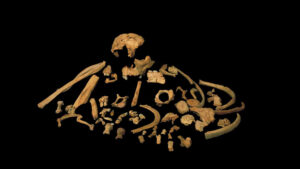
Homo antecessor is an extinct hominin species whose fossil remains were initially discovered in 1994 at a cave site called Gran Dolina in the Sierra de Atapuerca of Spain and formally named in 1997. The fossil remains were collected from a stratigraphic horizon identified as TD-6 located about one meter below the Brunhes-Matuyama paleomagnetic boundary (change of the magnetic polarity of the earth from normal to reversal). This boundary is dated to 780,000 years ago, providing an age of about 800,000 years for the fossil remains. Homo antecessor shows some similarities in its facial morphology with modern humans, and the discoverers initially argued that Homo antecessor might be the ancestor of the Neandertals and modern humans, excluding Homo heidelbergensis from the ancestry. However, the similarities were based on the face of Homo antecessor as preserved on the type specimen (holotype), which is a partial cranium of a child. Some researchers argued that the similarities that were described as characteristic of modern humans could have changed in the Homo antecessor child’s face with maturity and dismissed its status as a new species, while the discoverers argued that the similarities were taxonomically informative. While more specimens of the species were recovered through the years, the phylogenetic relationships of this species have been controversial since its naming in 1997. Some argued that Homo antecessor was ancestral to Homo heidelbergensis, while others suggested that it was on “offshoot” of Homo erectus that eventually went extinct. Later, one paleoanthropologist argued that Homo antecessor and Homo heidelbergensis are two different lineages and not an ancestor/descendant. In 2020, a molecular paleoanthropologist, based on the analysis of ancient proteins collected from a tooth of Homo antecessor and teeth from other extinct species, showed that this species is not ancestral to modern humans, but rather closely related to the common ancestor of modern humans, Neandertals, and Denisovans.